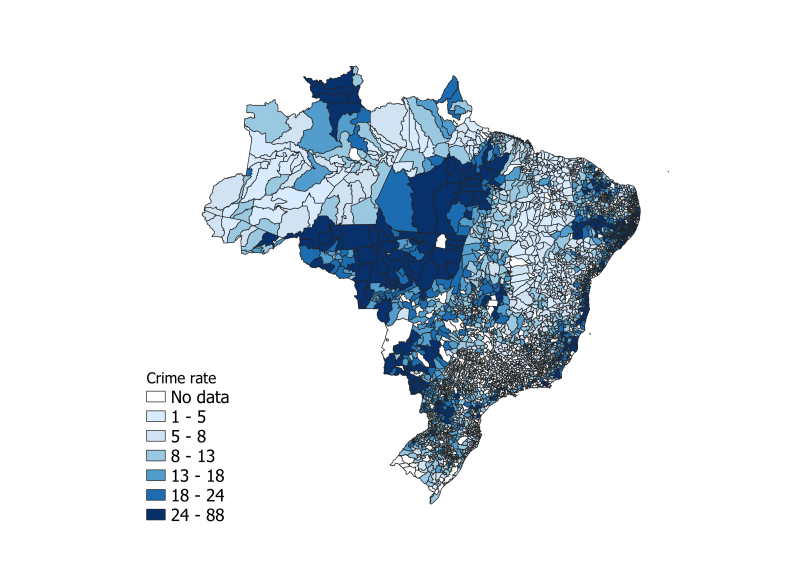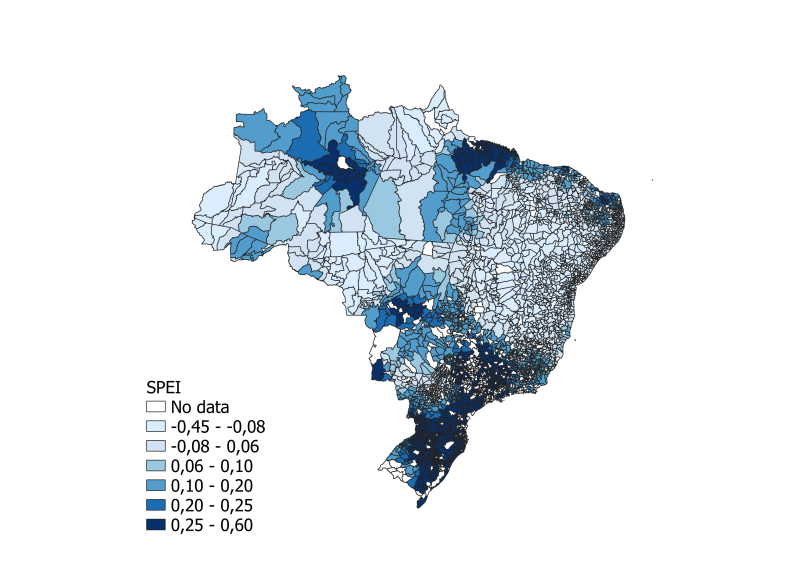Phoebe W. Ishak, 2022, World Development, 157, 105933
»
I find that adverse weather shocks (i.e., drought) immediately and significantly increase violent crime rates,
and that the effect persists beyond the growing season and over the medium term.
RESEARCH PROGRAM
Extreme weather events are becoming more common, and their adverse effects disproportionately impact developing countries. With more than half of developing countries’ populations residing in agrorural communities, climate change poses a major threat to local agriculture and agriculture-generated incomes. This could in turn trigger intense competition over scarce resources, which may eventually generate widespread violence. A growing body of literature has been seeking to examine the consequences of extreme weather events and climate change on civil conflict and social unrest. While the bulk of this literature has focused on studying politically-induced conflict, such as civil wars and institutional breakdowns, there have been few attempts to investigate non-political forms of social unrest, such as criminal activities. A few recent studies have documented a positive association between crime rates and high temperatures, yet without consensus on the mechanism behind this. Some emphasize the role of income and economic motives, while others cite non-economic factors such as weather-related depression, aggressive behavior or changing habits.
My analysis seeks to contribute to this debate by making use of variation in weather conditions across Brazilian municipalities to identify their effects on homicide rates. It makes a first attempt to discern weather effects on a broader set of economic and non-economic factors. Economic channels include not only agricultural output, but also all forms of economic activity, labor market response, poverty, inequality, local government budgets, and public services. In this regard, Brazil offers an excellent context to study the crimeweather nexus for several reasons. First, Brazil is one of the world’s leading agricultural producers, with exports of agricultural raw materials representing around 19% of its total exports and total agribusiness in terms of agriculture and industrial food production accounting for 35% of its exports in 2018. Second, agriculture in Brazil remains largely rain-fed and depends extensively on manpower, 35% of the country’s total workers being employed in the agriculture sector. It follows that adverse weather shocks like droughts can represent a major blow to agriculture-generated revenues and earnings. A recent example of this was the 2014-2017 period, during which the country witnessed the worst drought season in 100 years, which led to disruptions in the production of coffee beans and sugar and the downsizing of operations. Finally, Brazil’s homicide rate is very high, reaching 30.8 homicides per 100,000 inhabitants, compared to a world rate of only 6 homicides. To illustrate, Fig.1 depicts the spatial distribution of average homicide rates and level of drought as measured by the Standardized Precipitation-Evapotranspiration Index (SPEI). It shows higher homicide rates (left plot) in municipalities with high levels of drought (right plot).


Figure 1. Homicide rate and SPEI – Spatial distribution
PAPER’S CONTRIBUTION
Employing a distributed lag model that takes into account the spatial correlation of homicide rates, I find that adverse weather shocks (i.e., drought) immediately and significantly increase violent crime rates, and that the effect persists beyond the growing season and over the medium term. This contradicts the conventional view of weather effects as transitory shocks. To explain this persistence, the weather fluctuations are found to be positively associated not only with agriculture yields, but also with overall economic activity in a persistent way, providing local evidence of the existence of spillover effects through local demand. This latter effect is confirmed by evidence of the dominance of an opportunity cost mechanism reflected in fluctuations in total earnings and wages, particularly for agricultural and unskilled labor, over (un)-employment, local government capacity, poverty, inequality, and psychological factors. This is because earnings determine the opportunity cost of time allocation between legal and criminal activities and affect local demand. In addition, agricultural and unskilled workers are the most severely affected group, who are the most likely to commit crime.
FUTURE RESEARCH
My results provide relevant information for policy makers regarding the future consequences of global warming, especially for agriculture-based economies. Policies aiming at mitigating weather effects on agricultural yields and income are highly desirable. One approach that could be used to reduce income fluctuations is the introduction of insurance against negative shocks and the provision of safety nets. A long-run strategy should involve reducing crop dependence on rainfall by installing new irrigation systems or adopting drought-tolerant crop varieties, Farm diversification too can reduce the risk of exposure. Finally, the persistence of weather fluctuations suggests the need to explore the wider effects of climate-induced agriculture shocks as well as the other mechanisms at play, such as urban-rural migration and participation in social movements; this is left for future research.
→ This article was issued in AMSE Newletter, Winter 2023.
© CESARVR / Adobe Stock